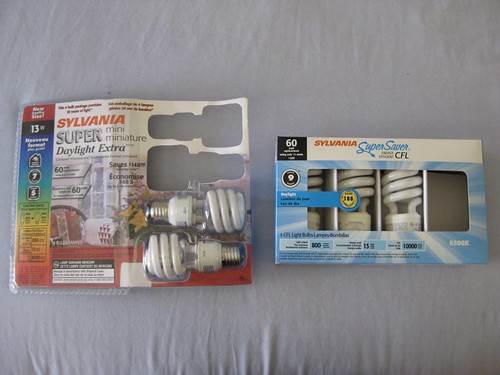
The package on the left I bought around three years ago (the two bulbs are dead ones that I need to dispose of properly), the package on the right I bought last weekend.
The package on the left claims the bulbs last seven years (8000 hours). Of the package of four, I've had to replace two, and one just went in a month or two ago. It's not doing well on it's seven year claim. The new bulbs claim to last nine years (10000 hours). So... do you think they'll actually last nine years (as claimed), five years (two more than the old bulbs), four years (20% more), or three years (exactly the same)?
The old lightbulbs have 850 lumens flux, the new ones have 800. (It's daytime right now, so I haven't turned them on for a light output test... I'm not sure how I'd do that without equipment anyway.) They both use 13W.
The old bulbs are "Daylight Extra... Colour temperature is 3500K. Does not comply with ANSI specification C78.376-2001 for Daylight colour temperature (6500K)." New bulbs actually do claim to be 6500K, and are a noticeably different colour than the old ones when I flicked them on briefly to check. (Old one is yellow-white, new one is blue-white.)
The old bulbs came in an excessively large clam-shell package made from non-renewable petrochemicals, with no recycling symbol. The new ones come in more compact, recyclable cardboard.
Regular lightbulbs are being phased out all over, in favour of CFLs. I have two concerns about that:
1. What do you use for your porch light? CFLs turn off when the temperature drops too low. (Not a problem in NC, but does happen regularly in Winnipeg.)
2. Many CFL packages still say not to use the bulbs in enclosed fixtures, or in a sideways or upside-down position. What are you supposed to do for overhead lighting if you don't want a chandelier? (As is the case in my apartment? Is that why they don't last as long as they should? Or take so long to come to full brightness? ...Although I have those same problems with the tri-light in the living room, and it's upright and unenclosed.)
Even ignoring the concerns migraine sufferers have, they still have some issues to resolve.
Update: If I had to make a guess, I'd say the new bulb is brighter. It certainly comes on faster. The blueish light is going to take some getting used to, though.
4 comments:
I'm hoping led bulbs really start to drop in price soon...
That would be cool!
We only use CFL bulbs and have for several years. They aren't expensive here, but it did take some getting used to waiting for them to get to the full brightness. I've only replaced two bulbs in 4 years-two lamps I use a lot. I do use them outside and yes, sometimes it flickers off and is annoying, however, I don't leave outside lights on unless I am outside, so...
Growing up, it was considered a safety thing to have a porch light on. It helps emergency vehicles find the right address. Being a bit farther north, winter is probably colder here, and it gets dark earlier... and so having an outside light that works in the cold is more important. (In the winter, we leave in the morning in the dark, and come home in the dark... but the extra daylight in the summer makes up for it.)
Post a Comment